LaMancha Goat Breed Information
This post may contain affiliate links, view our disclosure policy for details.
The LaMancha goat breed is a milk production goat breed. LaMancha goats are easy-going and friendly, they are the only American made breed of goats and they are a great choice for farming or even just as pets. In this post, you’ll learn everything that you need to know about LaMancha goats.
My first experience with goats was with Nigerian Dwarf goats. We had just moved out of town to the country and I couldn’t wait to put my hands on some farm animals.
I wasn’t ready to own a cow but I knew that I could handle a few goats. Friends gifted us two Nigerian Dwarfs and one buck, but very quickly I realized that they weren’t friendly and hard to handle (they weren’t raised with much human interaction) and produced very little milk. We ended up using them to clear brush at the farm.
I was back on the market looking for the right breed of goat for me…
I was looking for a goat breed that would give me a good amount of milk per goat so I didn’t need to own a lot of them to support all of our dairy needs. If I could have two or three does and one buck and have all the milk I need this was ideal for me.
LaMancha Goat Breed Information…
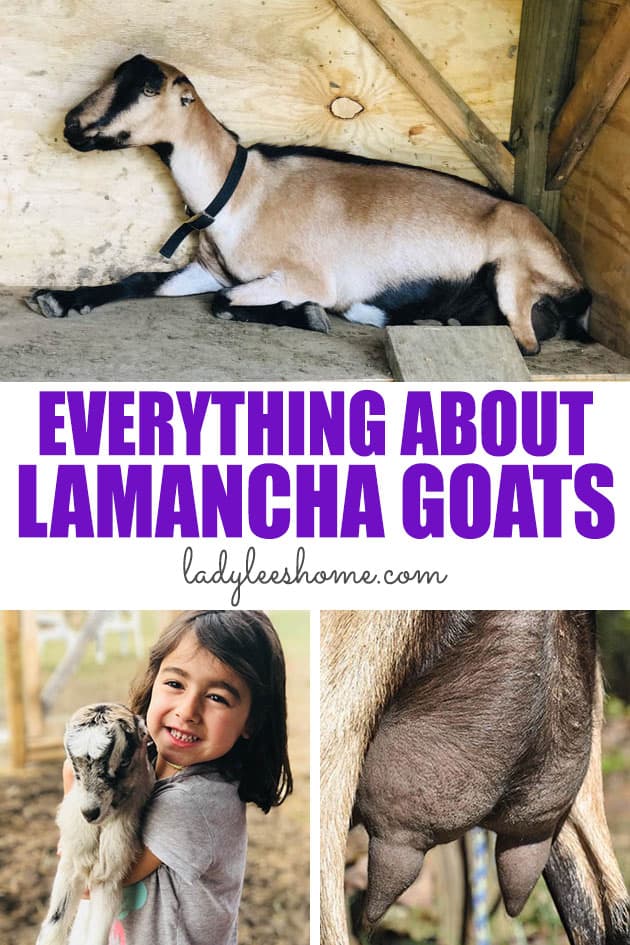
As far as temperament goes… I didn’t realize that I could choose. I thought a goat is a goat, they are naughty beings who jump fences and bite everything.
I started researching and after a while, it boiled down to three goat breeds: Nubian, Alpine, and LaMancha.
All three breeds are known to be amazing milkers but what sold me on LaMancha goats (aside from milk production) was their breeding season, their temperament, and the fact that they carry proudly the sign “Made in America.” Gotta love and support your country, baby.
Here is what we are going to go over in this post:
- Origins of LaMancha Goats
- What Are LaMancha Goats Used For?
- How Much do LaMancha Goats Cost?
- Where to Find LaMancha Goats For Sale?
- What do LaMancha Goats Look Like?
- How Big is a LaMancha Goat?
- LaMancha Goat Colors
- Do LaMancha Goats Have Beards?
- Do LaMancha Goats Have Horns?
- Do LaMancha Bucks Smell?
- How Long do LaMancha Goats Live?
- LaMancha Goat Personality
- How Often do LaMancha Goats Come in Heat?
- How Much Milk do LaMancha Goats Produce?
- What to do With Goat’s Milk?
- What to Feed LaMancha goat?
- How to Care For LaMancha Goats
Let’s get to know the LaMancha goat breed a little better…
Origins of LaMancha Goats…
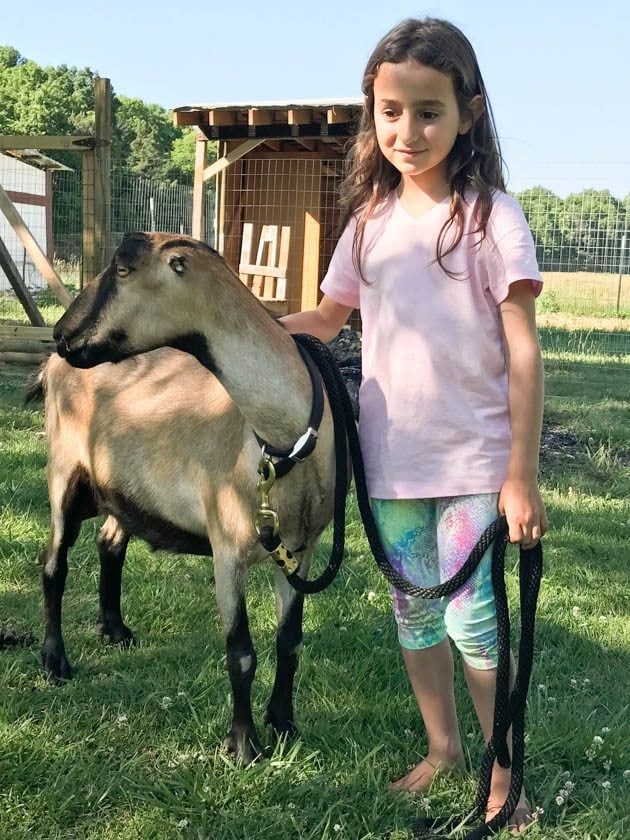
LaMancha goats (also called American LaMancha goats or LaMancha…) were bred by Eula Fay Fery in 1927. She lived in California and later moved with her herd to Oregon.
LaMancha’s distinctive characteristic is their nonexistent ears. Although throughout history there is a record of short-eared goats (mainly in Spain) there had never been a registered breed of “earless” goats in the world until the LaManchas.
Eula noticed a couple of goats with very short ears in her herd. They were really good milkers and were very friendly and she decided to selectively breed them. Within a few years, she was able to keep certain characteristics breeding after breeding and the LaMancha breed came to be.
This is the only dairy goat breed that was ever developed in the United States. The breed was recognized as a distinct breed in the early 1950’s and formally registered in 1958.
What Are LaMancha Goats Used For?
LaMancha goats are a dairy breed of goats. They can give up to a gallon of milk a day and are easy to milk. Most goat owners will choose them because of their milk production ability, however, they are kind, calm, and friendly and make great pet goats as well.
How Much do LaMancha Goats Cost?
You can expect to pay anywhere from $150 to $1500 per LaMancha goat. The higher price range is mostly for quality show goats but most pure bread LaMancha goats will cost around $350 depending on the time of the year, the availability and demand for LaMancha goats around you, the color of the goats, its markings, bloodline, and sex.
I bought my LaMancha goats from a registered breeder in VA and they cost me $300 and $350 per goat. I’ve since sold baby LaMancha Goats for anywhere from $150 to $400.
Where to Find LaMancha Goats For Sale?
The best place to find LaMancha goats for sale is to search for local LaMancha goat groups on Facebook. Once you find a group, you’ll probably see many listings for LaMancha goats kids for sale around March, April, and May when Lamancha goats give birth.
You can also post there that you are looking for a LaMancha goat and will most likely get a few responses back from the group members.
You can also find a list of registered LaMancha goat breeders on the American LaMancha Breeders Association and contact them directly.
Another good source of contact is the American Dairy Goat Association which is where people register their pure bread LaMancha goats.
What Do LaMancha Goats Look Like?
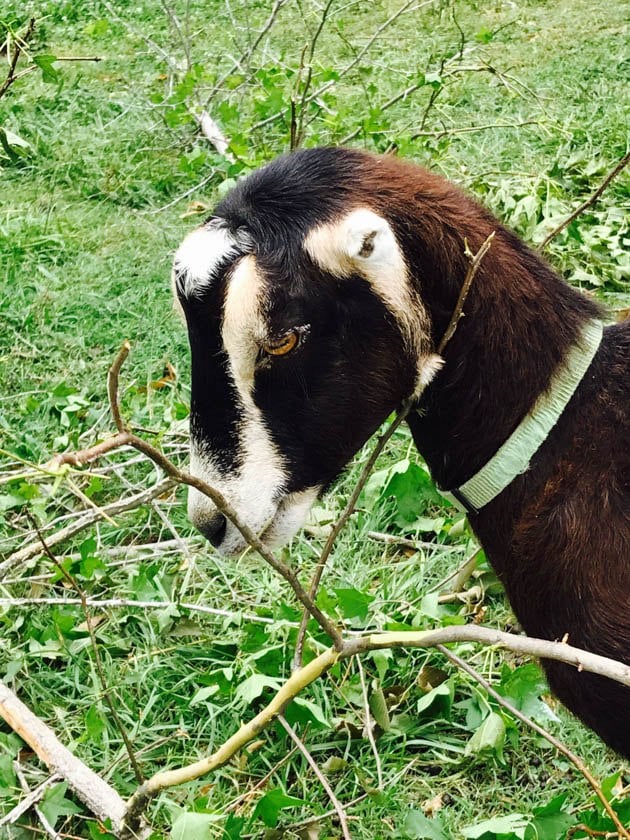
LaMancha goats are a large breed of goat (comparable to a large breed of dog like the Great Pyrenees for example), they can have mixed colors, and the most distinctive characteristic about them is their tiny ears.
The first time I looked at a photo of a LaMancha goat I was thinking where the heck did this alien came from!? It takes a few long minutes of staring at a LaMancha goat to get used to an animal without ears…
Obviously, they do have ears and the shape of their ears is their main distinctive and special characteristic. A registered LaMancha dairy goat can have two kinds of ears…
Elf ears – are about 2” long, wrinkled at the bottom, and their tip is usually pointing down but can sometimes point up.
Gopher ears – are about 1” long (I would say less!), there is really not much of an ear, it’s just folds of skin around the opening of the ear. The little bit of tip they have is pointing up.
All of my LaManchas have gopher ears just like Starlight in the picture above.
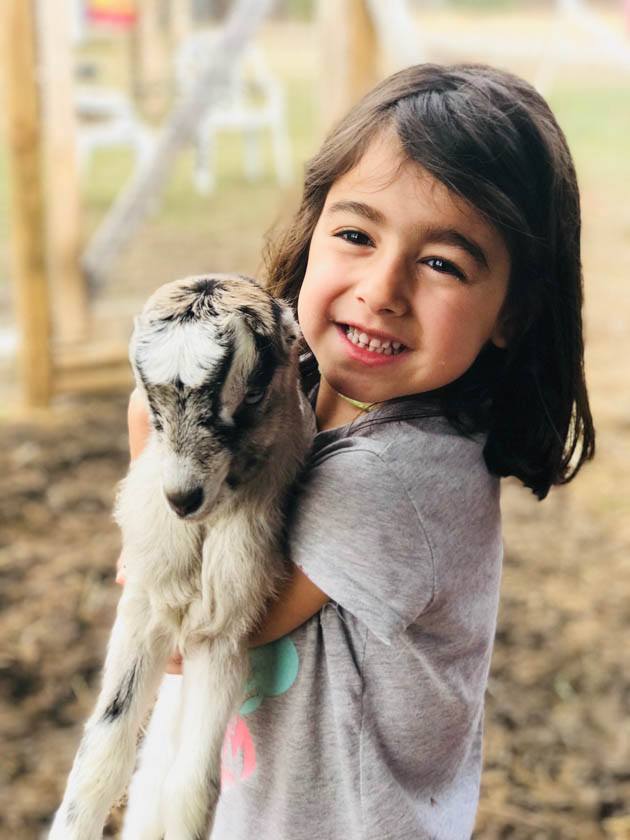
I say, if you are having a hard time looking at a Lamancha goat, start with staring at LaMancha kids. They are so stinken’ cute! In no time, you’ll fall in love and graduate to adult LaManchas.
How Big is a LaMancha Goat?
LaMancha goats are large goats. A buck stands at around 35” in the withers and weighs around 165 pounds. A doe will be just a bit shorter and around 130 pounds.
LaMancha Goat Colors…

They come in all colors and amazing color combinations. LaMancha goats can be white, dark brown, light brown, tan, black, and they can even have some grey hair.
Most of their markings are symmetrical, especially in the head. There can be different markings on either side of their body but from what I’ve seen so far they all have symmetrical markings on their head.
Do LaMancha Goats Have Beards?
Yes, LaMancha goats can have beards but not all of them do. Most of the bucks (male) have beards and some of the does (females) also have beards as well.
There is really no way to tell if a LaMancha kid is going to have a beard until it grows into an adult goat.
Do LaMancha Goats Have Horns?
Yes, LaMancha goats have horns just like most other goat breeds. The buck’s horns are larger than the doe’s horns.
You can dehorn a baby goat if you like but I never did it. The LaMancha goats that you see in the photos of this post were purchased without horns. Since then, all of the babies that were born here kept their horns.
LaManchas are a gentle breed (more on this in a minute…) so they never used their horns to hurt us, each other, or other animals around the homestead. They do like to play and butt heads but they never did any damage.
If you plan to raise LaMancha goats for milk you might be concerned about fitting their head in the milk stand with the horns… It might take them an additional second to get situated but the horns have never been a problem for us.
Take into consideration that the bucks do like to mess around… If they have enough room to run around, plenty of grazing land, and good company, they probably won’t cause much damage.
When I owned a buck I could only supply him with a small fenced area. He was bored and used his horns to mess with the fence on a regular basis. Fixing the fence every other day was not fun and I ended up rehoming him.
Do LaMancha Bucks Smell?
Unfortunately, LaMancha bucks smell just like any other goat breed buck. They pee on themselves and their hair contains a pheromone that is meant to cause the doe to go into heat and to increase cyclic activity (male effect).
Some homesteaders feel that the proximity of the buck to the does will change the taste of the goat’s milk. I think that this is true… We taste with our nose too and when a buck is close by the milk has more of a “goaty” taste to it.
If you are going to own a buck, you might want to make sure that you can keep him away from the females before you purchase him. Especially if you are going to keep LaManchas for milk production.
How Long Do LaMancha Goats Live?
LaMancha goats live between 7 to 10 years. This is a little shorter than other breeds so it’s important that you take that into consideration if you decide to raise LaMancha goats.
LaMancha Goat Personality…
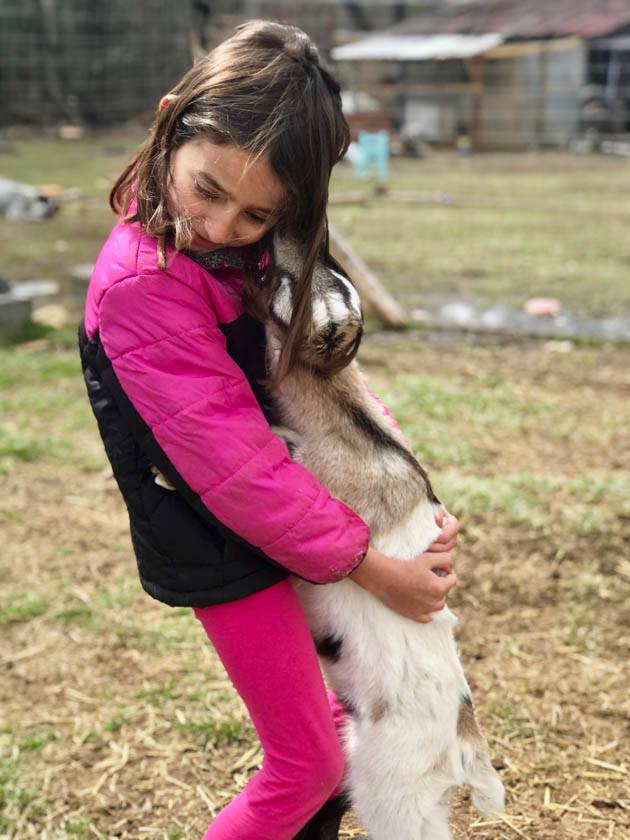
LaMancha goats are gentle and friendly. If they are bottle raised or raised with a lot of human interaction, they are easy to handle even though they are a large goat.
I guess that LaMancha kids are as playful and like to chew on everything just like other goat kids, but as they grow and become adults they mellow out and become this slow, gentle, sweet animal that is easy to care for.
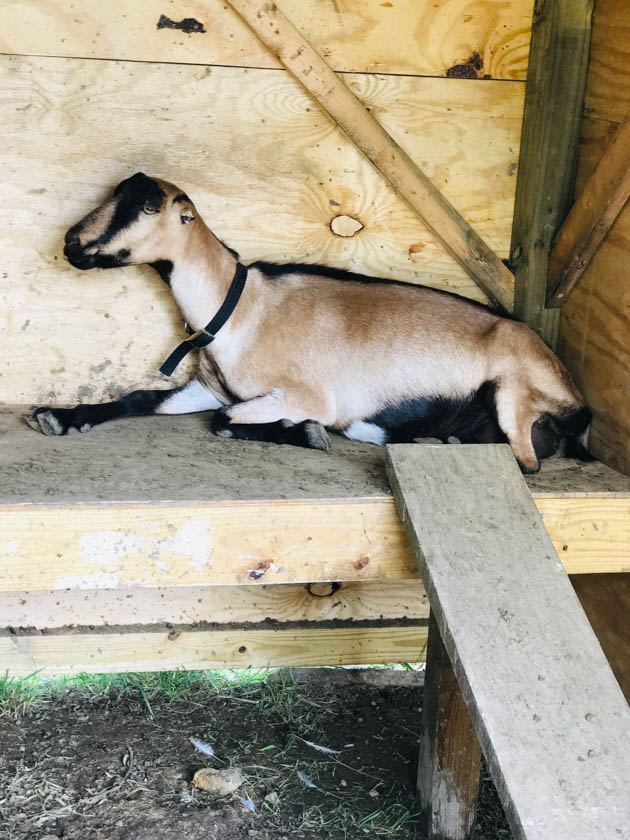
They spend most of their day just laying down somewhere. You’ll see them sunbath on the ground a lot when it’s a nice day. When it’s winter or a rainy day or just not so nice outside they spend a lot of time in their goat house.
We installed a two feet (high and deep) shelf for them in their goat house and they love laying on it. You can easily do this (all goats love it!) or you can find a $5 old coffee table in a thrift store and place it in their house.
The bucks are not aggressive at all (at least it’s true for all the ones that I have met so far). The only time that they can cause problems is if they are extremely bored. If they have enough room to roam around and another male or two to play with they are usually easy to handle.
The breeder I bought my goats from had the does and bucks sharing a fence and I had to ask them how that worked for them. I thought to myself that the bucks most likely go nuts when a doe is in heat…
They said it worked great and that they never had any problem. There was a little electric wire along the inside of the fence but that was it.
Because they are so gentle, slow, and friendly, LaMancha goats can make great pets!
How Often do LaMancha Goats Come in Heat?
LaMancha goats have a short breeding cycle. They will go into heat every 21 days for a day or two during the fall (from about September to December). They are ready for breeding in their second fall when they are fully grown.
When I found that out I immediately thought to myself that the main benefit here is that I don’t have to separate the buck from the does. Since I want them to get pregnant every year and they only are in heat for that short time period I can leave everyone together.
I’ve seen people do that but there are a few things you should take into consideration here…
First, if you care about bloodline and want to register your goats then that might not be a good idea. There is a huge debate about breeding sisters with brothers, fathers with daughters and so on.
I can tell you from seeing huge herds of goats in my home country Israel, where people actually still herd their goats like they used to do in the bible, that the herd is living together and breeding just happens.
But here in the US, it might be a little difficult to sell a registered goat if it’s a result of interbreeding. Not because of the goat, she or he might be perfectly fine, but because of how this sounds to humans.
So if you want more control of who is breeding to who, you’ll have to separate the bucks and the does.
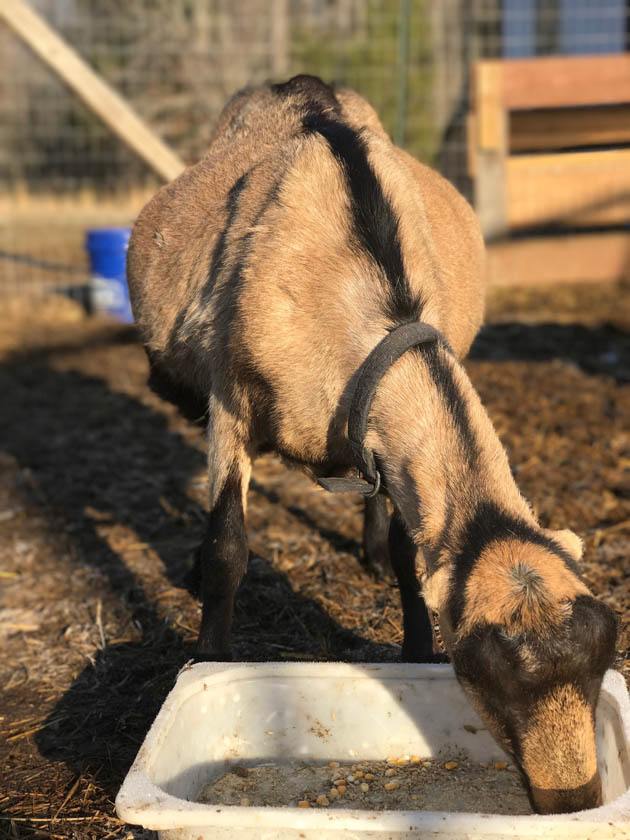
Second, I found out that I’ll need two fenced areas anyway because the does are not ready for breeding in their first fall. Let’s say a doe bred in the fall of 2018, it then has a 155 day pregnancy period so let’s say it gives birth (usually to twins or triplets) during March 2019.
The kids will not reach full size in the fall of the same year (2019). The bucks WILL be ready to service in the fall of 2019 even though they are not full size. The does WILL go into heat (most likely) in the fall of 2019 but their body will still be relatively small.
This is important and you have to take this into consideration. You might need to wait 2 or 2.5 years before you can breed a LaMancha doe whereas with other goat breeds, let’s say Nigerians, you can breed after just a few months.
So even if I decided to leave the bucks with the does I would still have to separate the young does because I don’t want them to get pregnant before they are physically ready. I ended up just keeping the does in one pen and the bucks in another.
I do still love the fact that they go into heat for just a short period. God knows there are a million things to do on the homestead and it makes it much easier for me when I need to deal with breeding just once a year.
I just place the does I want to be bred with the buck in the same fence and let them hang out together for a few days or until I see them breed. Then I return the does to the doe fence and that is it.
Update – I no longer own a LaMancha buck. I simply didn’t have the right conditions to raise one. Now, every November, I drive my LaMancha does to a friend’s house to visit her buck. He is a Nigerian Dwarf so this match is creating Mini-LaMancha babies.
How Much Milk do LaMancha Goats Produce?
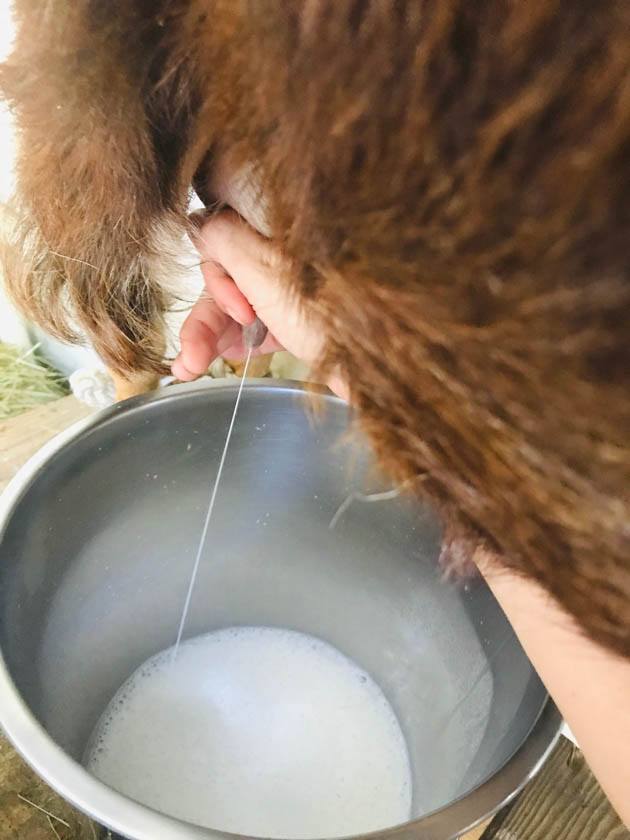
LaMancha goats produce around a quart of milk per milking. This amount might vary depending on the goat, the time of the year, and what you feed your goat.
I find that first fresheners (does that give birth for the first time) might give a little less milk then second or third fresheners. Does will give more milk in the months after the birth and might give less milk during the fall when it’s their breeding season.
Also, if your goat is eating fresh green leaves or brush or weeds and grass it will probably give more milk than a goat that only eats hay.
So the amount of milk can vary, but for the most part, all of the LaMancha does that I have owned so far gave me about a quart a milking. If I milk twice a day, that’s one-half gallon a day, way more than enough for us (a family of five).
Another great thing about LaMancha goats is that they can keep giving milk for two years without being bred. So, the goat will start giving milk after she gives birth to the kids in the Spring. Then, she doesn’t need to be bred again that fall, she can keep giving milk until the following fall (if you don’t want to breed her again).
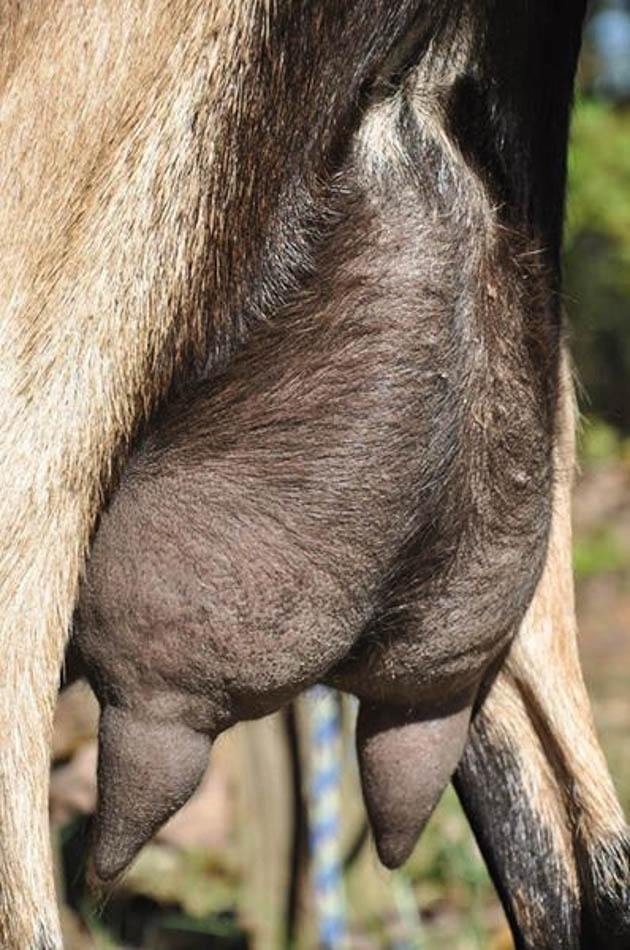
LaMancha goats have large udder and long tits. This makes it very easy to milk them. They are also tall which means that you can fit a large stainless steel bucket under them (the same one that you’ll use when milking a cow).
I usually use both hands to milk and I am usually done in just a few minutes.
What to Do With Goat’s Milk?
LaMancha goat milk contains 3.1% protein and 3.9% butterfat. You can use it in any cheesemaking recipe. It’s sweet and rich but not heavy and is very easy for our body to digest.
Even though it’s a good amount of butterfat it’s still going to be hard to make butter from this milk. There is just not a lot of it and it takes time to collect enough.
But aside from butter, you can make many many kinds of cheese from goat’s milk… Learn the basic process of how to make cheese and gather your cheesemaking equipment.
Then you can make chevre cheese, feta cheese, ricotta cheese, this delicious rennet goat cheese, or use your milk in any other cheese recipe.
In addition, you should know that you can can milk and you can also use your milk to make goat milk soap.
What to Feed a LaMancha Goat?
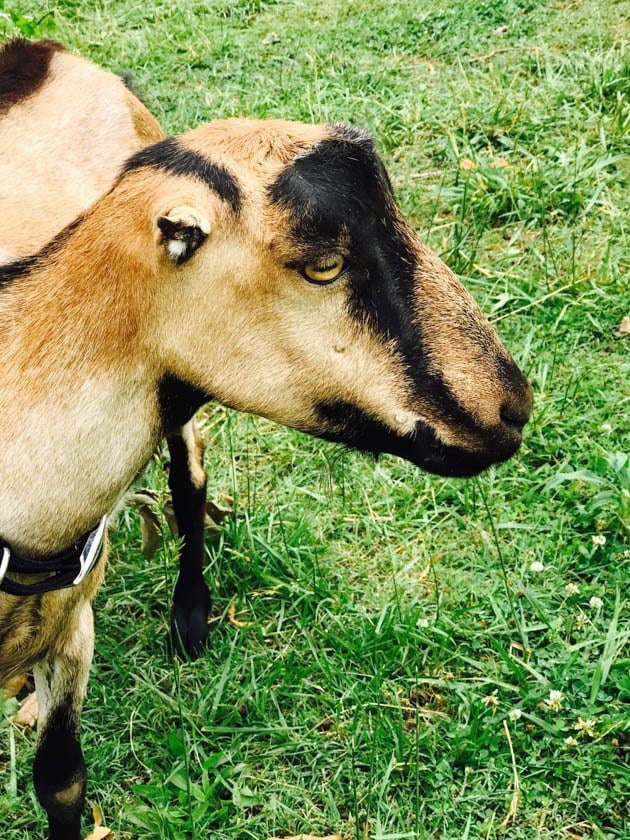
Since LaMancha goats are a milk production goat and most people raise them for this reason, the richer their diet the more milk you’d get and the tastier the milk will be.
If you have a large pasture or a wooded area that you can let them hang in, where they’ll have access to fresh greenery, that’s best. Other than that, I keep it pretty simple.
I feed my Lamancha goats a cup of goat pellets a day (2 cups, one in the morning and one at night if I milk twice a day), one flake of hay per goat a day, and a handful of chaffhaye a day.
I don’t buy the organic goat pellets… Just the regular pellets from a local feed mill. The hay that I give is horse quality hay. If you can give it in a way that the goats can’t waste it (like hang it in a hay bag for example) you can give it free choice but I find that my goats won’t eat more than a flake a day per goat anyway.
Chaffaye is fermented alfalfa. It’s a nutrients rich full feed and it’s a great addition to the meals of all livestock. Here, I have to buy it from a dealer, I can’t find it in the stores. You can learn more about chaffaye here.
Aside from good feed, always make sure that your goats have access to fresh clean water, of course.
How to Care For LaMancha Goats…
Aside from good feed, caring for LaMancha goats is pretty much the same as caring for any other goat…
Housing – they are going to need some sort of a goat house where they can be protected from the rain. Like I mentioned before, they like to lay on a “shelf” off the ground so if you can build something like that they will enjoy it.
Their yard should have some shade but also access to the full sun. They love laying on the ground and sunbath in the summer.
They can definitely share a fence with other animals. My goats live with the chickens and ducks and all is well!
Deworming – this is a huge topic for another post, but let me just tell you quickly how I do it… I always have two to three kinds of dewormers on the shelf. I don’t follow a schedule, I give a different dewormer each time in different intervals. This ensures that the worms don’t get used to anything.
About once a week, I pull the lower eye lid of my goat down and look inside the eye. If the skin is red the worm load is fine, If I notice that the skin starts to get pale and lose its redness this means that the worm load is increasing and it’s time to deworm.
Again, deworming can be a tricky subject and it depends on where you live but generally, this is my process.
Hoof trimming – LaMancha goats, like every other goat, needs to get their hooves trimmed every couple of months.
There is nothing to it really… Get yourself good goat hoof trimmers and clip their nails every couple of months.

LaMancha goats are a great breed of goats! I hope that the information I shared here with you will help you raise LaMancha goats or make the decision to go ahead and get your first LaMancha goats!
At the end of the day, here are the reasons that made me choose them…
- Their calm, friendly, and easy going temperament – especially since I have little kids that are doing chores.
- The amount of milk they give – I wanted to be able to have just a couple of goats and still have plenty of milk.
- Their breeding cycle – I didn’t want to deal with animals that go into heat every month. A couple of times a year is enough for me.
- They are made in America – there is pride in that, I say!
It has been a few years since I got my first LaMancha goat and since then I’ve never looked for another breed. I didn’t feel the need. They truly cover all the bases and provide us with plenty of delicious milk while not demanding a whole lot of work.
In my book, that’s a keeper!



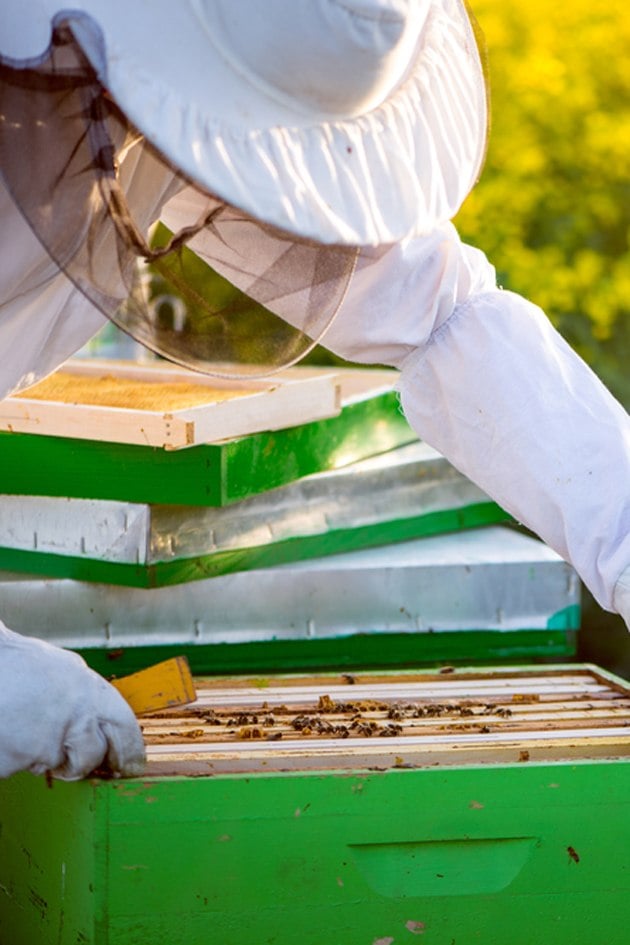
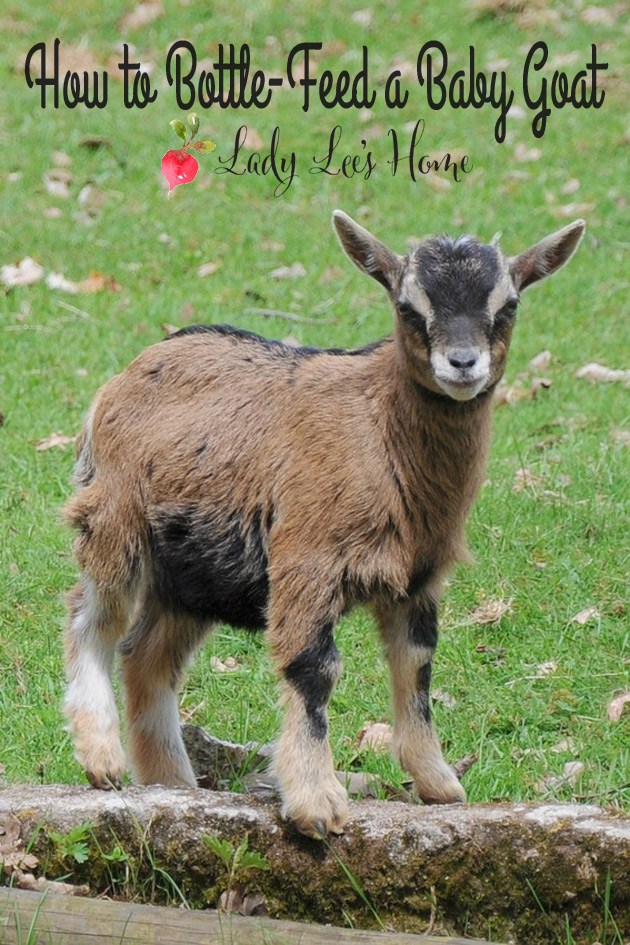
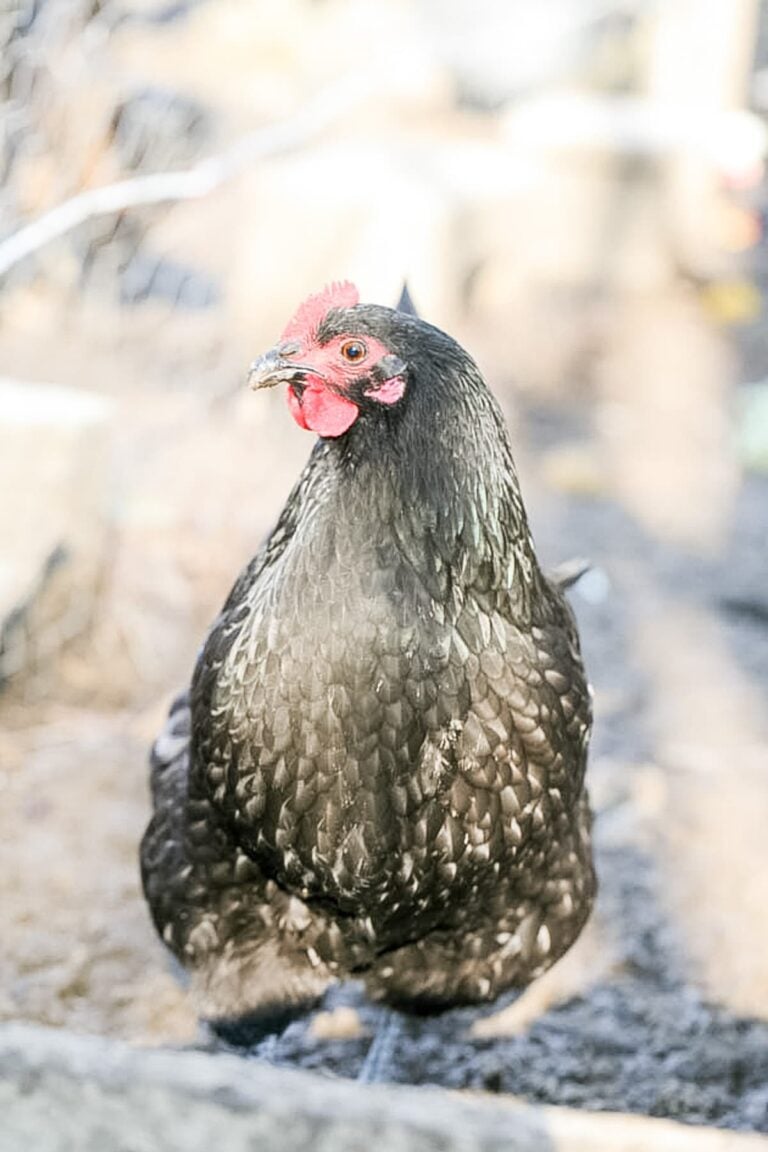
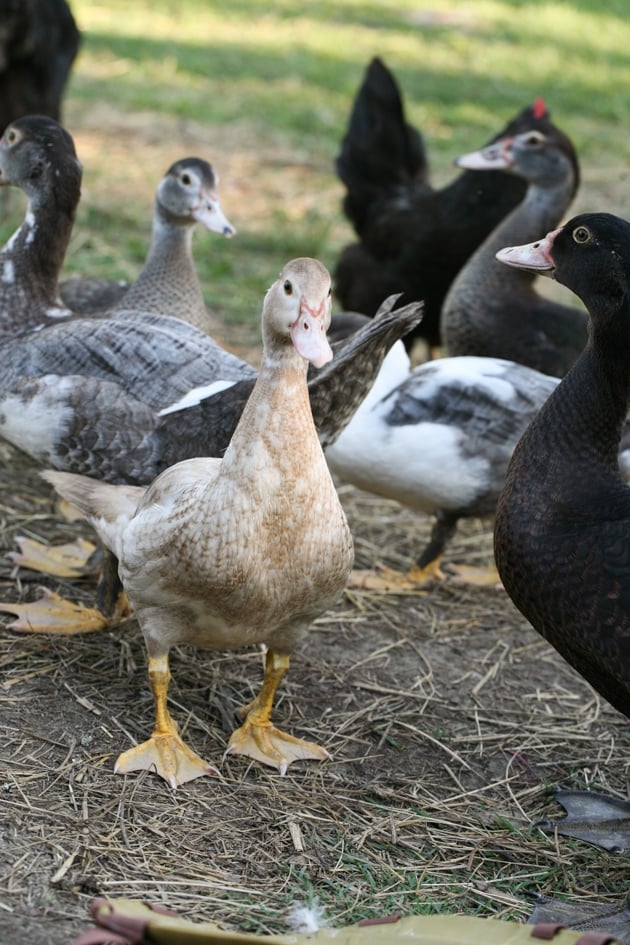
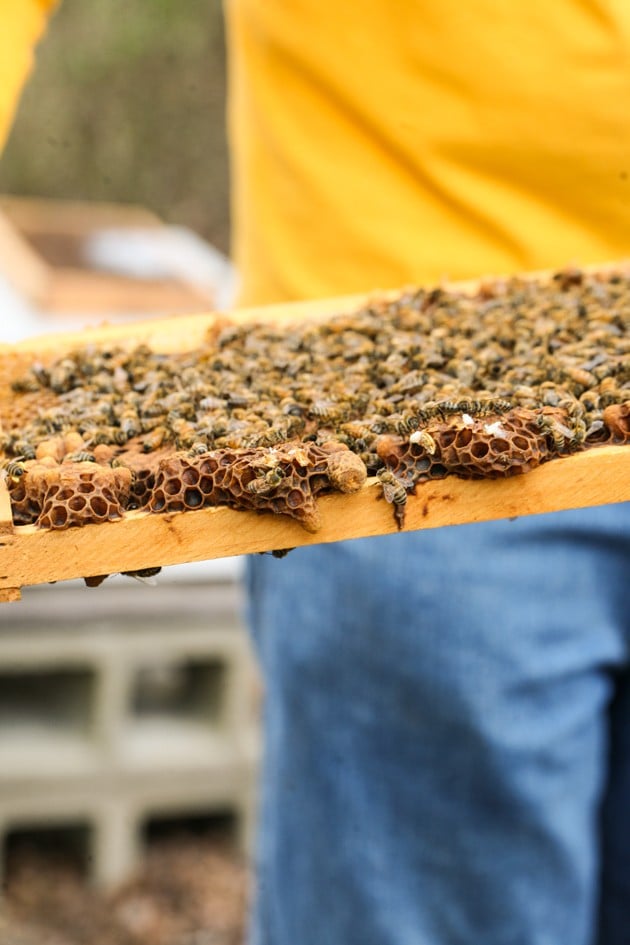
Interesting reading. I used to have many does. Unfortunately I am now down to only having a billy.Debating wether to sell him or get more does. Thanks for the article
You are welcome. Thanks for stopping by!
I started with a lamancha and a saanan as my 1st goats. I sold the Saanan after a couple years to focus on the lamancha line. I have kept one of her daughters and one of her granddaughters. My original doe is actually polled, which I have learned that is a rare thing among lamanchas. I am hoping for a polled doe from her this year. All of my lamancha does give me a gallon a day when they 1st freshen and are pretty steady with that amount until I start to dry them off after they are bred. I enjoyed reading your article, thank you.
They are a great breed! Especially for milk production. Thanks for stopping by.
Thanks so much for the great article! I just purchased my first purebred LaMancha and hope he has the qualities you list. I purchased a buck first, just because lamanchas are few and far between in my area. I am looking for a nice registered doe now. I have several crossbred six month old does. I know there is some Nigerian Dwarf black I’d in them and don’t have a clue what other breeds are mixed in. I purchased their dams from someone who had Nigerian Dwarf but had some mixed breed does given to her. The does produced doelings less than 24 hours after I brought them home. I sold the does after the kids were weaned, and kept the girls with the smallest ears.
They are amazing goats! I had them producing a whole lot of milk for us and they are easy to handle as long as you have enough space for them.
what do you feed bucks or kids and how much?
My ducks eat laying pallets just like the chickens.
The goats kids say on mama’s milk for at least three months and also eat goat pallets.
Thank you for the info . We are new to goats we bought a 6 yr female and at the time a 2 mo old male to breed her with . All was good until mating season now omg he has turned into a monster lol. I’m pretty sure it’s just his hormones but he’s a lot to handle at times. He likes to kick and jump on us at times . I’m hoping he calmed down after the season . Other than that they are great goats. He’s not aggressive . She will go after my dogs big and small they all know to stir clear of her. She Is a great Milker . They are easy keeps and know their names.
Any male goat is a pain in the ….
They aren’t easy.
Thank you for all of the information that you have provided. My granddaughter has a
Nigerian Lamancha Kunekune kid. The doe had 4 and could not nurse them all. My granddaughter bring a VET TECH took one of the kids (male) and has bottle fed him. She named him TURTLE because of his coloring. He is 4 weeks old today. My daughter says he is spoiled and quite a little character. She sent me photos of him and he is so cute.
I have made notes and will email them to her. TURTLE is not registered. He is just going to be a pet. She has a collar on him and is training him on a leash so when the dog gets walked TURTLE can walk along.
Sounds like he’s gonna have a wonderful life!
Hi. I live in SC and I just rescued 3 Lamancha goats. They were given to me. They all have horns and are really sweet I have already got mom and daughter leading and wearing a collar.
I can’t touch the buck. He is challenging.
Could you give me some pointers on worming schedule and feed.
My biggest tip ever when it comes to worming is: DON’T follow any schedule! The parasites get used to the schedule and learn how to survive it. I have a few different kinds of dewormers and I give something different each time. If I deworm tomorrow, I might not deworm again for three months. Then I’ll worm again a month later, then four months later, and so on.
I keep a close eye on the redness in the inside skin of the eyelid of the goats. You just hold their head and pull the lower eyelid down. If it’s red, you are good. If it’s white you are in trouble. The worm load is big and you have to deworm right away. If you just got them, check now. If you need to deworm, worm three times in intervals of ten days to make sure you kill the lifecycle. if you deworm just once, you’ll kill the adults but in a few days, more eggs will hatch. You want to make sure to do a good cleaning at the beginning.
As far as feed I do hay (cause my goats are in a small fenced area). One flake per goat per day in the morning (sometimes I give another one in the evening especially during the winter).
Regular goat pallets from the local feed mill (you can do the fancy organic feed but I just don’t have the budget for it).
And a cup to two cups of chaffey per goat per day.
As for the buck. It will take time. Just keep loving on him and he’ll eventually come around.
I hope that this helps! And good luck. They are amazing goats!
Thank you for this information! I have been on the fence of what breed to start my herd with. I have a business, 4 kids, and lots of animals. I need an breed that is not going to cause more trouble than benefit. My husband would not be happy with goats destroying things he built either. LOL.
And, you know what? I can totally understand him! Goats can be a pain in the backside. The Lammanchas are so easy going. I hope that you’ll like them. Thanks for stopping by!
Hi. Enjoyed your article. Just lost one of my twin. LaManchas. His brother, his horse companion an I are sad. Want another wether LaMancha but may have to wait until the goat shows next spring. Any suggestions
I found my goats on Craigslist. Just search in your area. Maybe you can find a Lamancha to add to your herd.
Sorry you lost her, I know it’s hard.
Thank-you!
That was so informative and inspiring!
Patricia 9
Happy this is valuable! Thanks for stopping by!
You didn’t mention how much you feed them and if you feed morning and eve?
I have 2 does and they are only giving 12 oz to 30 oz a day milking once daily and it seems one day one give more and the other less, the next day it is opposite. One udder on each of them is always less too.
Any ideas to increase production? Seems like if I give another cup of grain and alfalfa at night they produce more but one is getting fat, so I try to give her less grain.
I feed morning and evening. 3/4 cup of grain per goat (just regular store-bought) mixed with whole corn (I have a large aluminum bin and I mix 2 50 lb bags of goat pallets and one 50 lb bag of whole corn in there and feed this mix).
I sold some goats so I only have three now. I give one flake of hay in the morning and one at night. If you have a hay feeder I think it’s better to just keep it full and let them have hay free choice (unless they have a large pasture or wooded area to forage).
It’s normal to have one udder larger and producing more than the other.
To increase milk production I wouldn’t give more grain. Look for a product called chaffhaye, it’s amazing. Google it to learn more. If you can’t find that, I would add alfalfa on a regular basis. Also, make sure to check for worms and deworm.
I hope this helps!
I’m a fan of Nubian goats. Many people don’t like them because they are a very vocal goat but I haven’t found that to be a problem unless they are unhappy about something. They are a bit larger than La Manchas but are also very loving if you give them attention. Their long ears are to me their most attractive feature and their milk has the highest butterfat percentage of all the goats so it makes wonderful cheese. I have several friends who have La Manchas and they are indeed, a wonderful breed, but Nubians will always be my first choice.
I’ve heard great things about them from many people! I love hearing my animals but to a point. I had guineas before and could not stand the noise. Some people told me that Nubians are loud and some say it’s not too bad at all… But everyone loves their milk!
Thank you so much for your posting. I received lots of helpful information. We have a large piece of property on which we keep several animals including 24 pigs, 6 chickens, 2 goats and a sheep. We had 3 goats, a very mean and ornery male, but we had to get rid of him. He was being mean to not only our 6 year old boy, but he almost broke the leg of our almost 2 year old male goat because he didn’t want anyone else near Mama Goat. That included me, but I would just grab hold of his beard when he tried to butt me. LOL I enjoyed caring for and interacting with the goats and their personalities and I was still sad to see our mean old boy go… On New Years Day 2019, Mama Goat surprised us with a brand new baby. We have a couple gators and coyotes who hang around the property and have claimed several piglets and chickens, so we decided to take the baby and bottle feed her. We got extremely attached to each other and I became “Mama” to her. Sadly, she passed away 2 weeks ago yesterday at 4 1/2 months old…and my man couldn’t bear how broken hearted I was over losing my baby, so he brought home a new baby for me on Easter. She’s just as sweet and loving as my Happy was, and extremely calm as you were saying is characteristic of a Lamancha. Her mother is a Mini Lamancha and her father is a Nigerian Dwarf and I’m curious to see how her temperament will develop after reading your posting. I’m glad to report she favors the Lamancha in both physical appearance and temperament so far. She has beautiful symmetrical markings and the sweetest, most gentle personality. Once her ears grew on me, I fell in love with this breed of goat, especially this little girl. Our little boy kept calling her Happy after the first baby, so I named her Joy which she’s brought to me during such a sad time. Thank you again for your information. I wish you and your goats all the best.
Sounds like she is going to make you happy! What happened to the first baby? Why did she die?
I have a friend who is going to try and breed mini lamanchas… I am curious to see how it will work.
As crazy as this is going to sound…I used to take Happy everywhere I went. This particular day I had several errands and she was unable to come with me. She tried to get out of her pen and got her head through the bars. Her horn got hung up and she couldn’t get her head back in. She couldn’t get to her water and it was a hot day here in FL. When I got home I got her out and gave her plenty of water and some Bounce Back. She began to follow me but had a hard time holding her head up. I thought maybe she was just simply exhausted so I put her back in the pen for the night as I did for 4 1/2 months. When I woke up the next morning, she was gone and my heart shattered. I still miss her every day, but my heart is on the mend and full of joy and Joy. LOL Joy is sitting on my lap as I type this reply…
Good luck to your friend. I’d love to see pictures.
I hate when stuff like that happens but it’s part of raising animals.
I’m happy you have Joy!
Thank you so much for this! We are in the process of deciding what breed(s) we want on our homestead. I want some for both clearing the land, and some for milk (obviously). I was leaning toward Nigerian Dwarves, but I may rethink that based on your experience. Perhaps if I get some who are more acclimated to humans I’ll be ok. (Even if not, they are so cute!)
Thanks again for the information on Lamancha. I’ll be sharing this post with my hubby when we return to the subject.
You are welcome, Amy! Take into consideration that when it comes to food, a goat is a goat 😉 They all love to eat brush so milk goats can help you with that too. On the other hand, Norwegians can also give milk, just much less than Alpines, Lamanncha, and Nubians. The thing with them is that they go into heat ALL THE TIME so if you are ok with managing breeding closely and having (and milking) more than a few goats you can have milk all the time.
I have a friend who has a few Nigerians and she rotates their breeding so she always has four goats in milk. She also always has baby goats to take care of and births and breeding to pay attention to. For me, it will be too much work, but it works for her. It’s just a matter of personal preference.
Thanks for stopping by! If you have any additional questions in the process of choosing your breed let me know. I’d be happy to help!